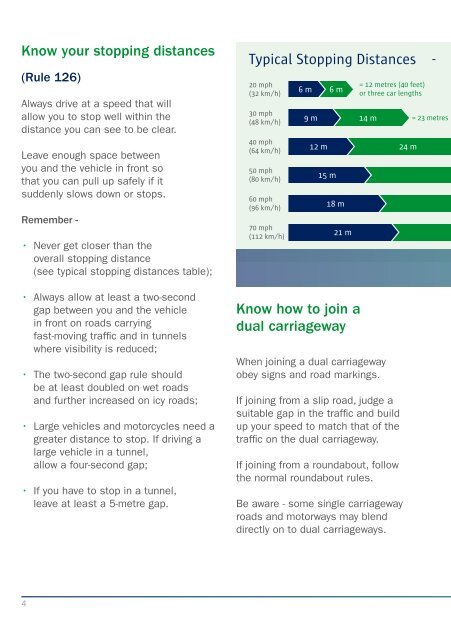Dual Carriageways
qiXO303Dthw
qiXO303Dthw
You also want an ePaper? Increase the reach of your titles
YUMPU automatically turns print PDFs into web optimized ePapers that Google loves.
Know your stopping distances<br />
(Rule 126)<br />
Always drive at a speed that will<br />
allow you to stop well within the<br />
distance you can see to be clear.<br />
Leave enough space between<br />
you and the vehicle in front so<br />
that you can pull up safely if it<br />
suddenly slows down or stops.<br />
Remember -<br />
• Never get closer than the<br />
overall stopping distance<br />
(see typical stopping distances table);<br />
• Always allow at least a two-second<br />
gap between you and the vehicle<br />
in front on roads carrying<br />
fast-moving traffic and in tunnels<br />
where visibility is reduced;<br />
• The two-second gap rule should<br />
be at least doubled on wet roads<br />
and further increased on icy roads;<br />
• Large vehicles and motorcycles need a<br />
greater distance to stop. If driving a<br />
large vehicle in a tunnel,<br />
allow a four-second gap;<br />
• If you have to stop in a tunnel,<br />
leave at least a 5-metre gap.<br />
Know how to join a<br />
dual carriageway<br />
When joining a dual carriageway<br />
obey signs and road markings.<br />
If joining from a slip road, judge a<br />
suitable gap in the traffic and build<br />
up your speed to match that of the<br />
traffic on the dual carriageway.<br />
If joining from a roundabout, follow<br />
the normal roundabout rules.<br />
Be aware - some single carriageway<br />
roads and motorways may blend<br />
directly on to dual carriageways.<br />
4


